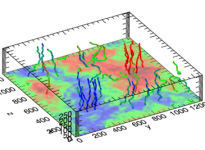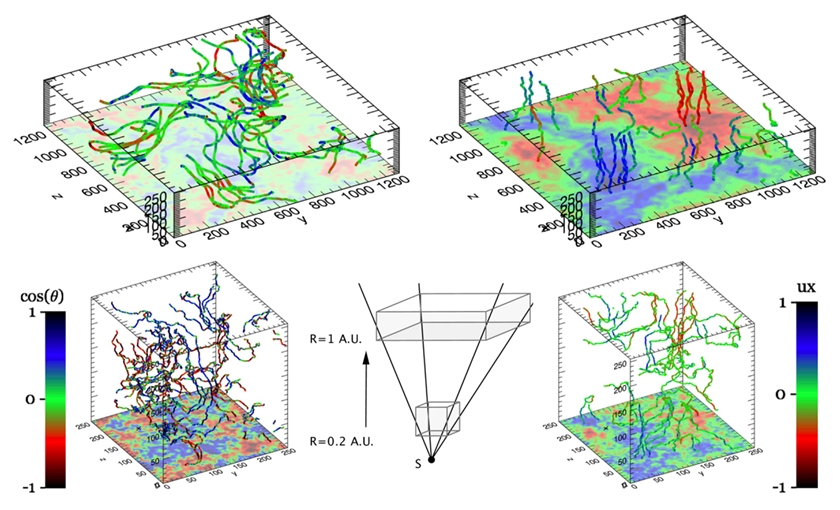The imprints of expansion on solar wind turbulence

Numerical simulations show that solar wind expansion affects the evolution of turbulence in the heliosphere, causing the emergence of strong transverse magnetic fields and of radial velocity jets.
Power and component anisotropies are routinely observed in the solar wind data. Power anisotropy refers to the different energy residing along wavevectors parallel and perpendicular to the mean field. More recently, thanks to CLUSTER data, full 3D anisotropies have been reported, that is axisymmetry does not hold at inertial range scales of solar wind turbulence. Component anisotropy refers to the different amount of energy residing in the components of the velocity and magnetic field fluctuations. Both anisotropies are difficult, if not impossible, to explain in the context of homogeneous (anisotropic) turbulence, because although being partially recoverable, their magnitude is smaller than that observed.
Including the spherical expansion in numerical simulations of turbulence
(Dong, Verdini, Grappin, ApJ, 2014) have allowed us to recover both anisotropies: a non-axisymmetric power spectrum and a component anisotropy that favors magnetic fluctuations over velocity fluctuations, and transverse (T,N) components over radial (R) components. Their combined effects can be thought as a selective decay that damps preferentially some components, thus affecting the development of turbulence and hence the energy of fluctuations (components) at different scales.
In
the figure we show the result of such a selective decay in the real-space, allowing us to highlight the presence of large-scale structures. We compare the initial magnetic and velocity field lines at a heliocentric distance D=0.2 AU (bottom) and their final state at D=1 AU (top), after turbulence have experienced about two turnover times under the effect of expansion. No mean magnetic field is present in order to highlight the sole effects of expansion.
For homogenous (isotropic) turbulence we would find chaotic patterns of the field-lines, very similar to those shown for the initial state. On the contrary the final state of expanding turbulence shows that:
1) the mean field is basically transverse,
2) the velocity field is organized in two large-scale jets, flowing respectively at a faster and slower speed with respect to the ambient solar wind.
While jets and micro-jets are also found in solar wind spectra, the transverse magnetic field is not dominant in the solar wind. Note that these large-scale features emerge in the heliospheric evolution because the other components decay faster, being subject to turbulent damping. In other words, the energy residing from start in the emerged structures (B
T,N, U
R) does not participate to the cascade. This can be seen by comparing the isocontours in the bottom and top panel of the velocity field: the two-stream structure is already present at the initial stage, but it is noisy and less extended because of the presence of fluctuations in other components.
These results suggest that the jets, observed in solar wind data from D>0.3 AU, are already present at inner unexplored heliocentric distances, while coronal turbulence should possess smaller transverse components compared to our simulations.
 Figure:
Figure: Field lines of B (left) and U (right) at the initial (bottom) and final (top) state of MHD turbulence in Expanding Box Model simulation. The initial state is at 0.2 AU from the Sun and is made up of a superposition of random Alfven waves, kinetic and magnetic energies are at equipartion, no mean field is present. The final state is at 1 AU, after turbulence has experienced about 2 eddy turnover times. Magnetic field-lines are colored according to the angle q between the magnetic field and the radial (vertical) direction. Velocity field-lines are colored with the intensity of the radial (vertical) velocity, U
R=ux. Isocontours represent the same quantities (respectively q and U
R) on a plane of the simulation box. Distance units are arbitrary, but take into account the aspect ratio due to expansion.
Comparing the bottom and top panel one can see that expansion allows the emergence of strong transverse components of the magnetic field and of two large-scale and uniform streams, the latter flowing respectively faster (blue) and slower (red) than the ambient solar wind.
Posted by: Andrea Verdini
Reference
Dong Y., Verdini A., Grappin R., ApJ, 793, (2014)
"Evolution of Turbulence in the Expanding Solar Wind, a Numerical Study"
Link: http://adsabs.harvard.edu/abs/2014ApJ...793..118D